
Top 25 Rankings 1901-1935
1910 National Championship
Home
1910
College Football Top 25
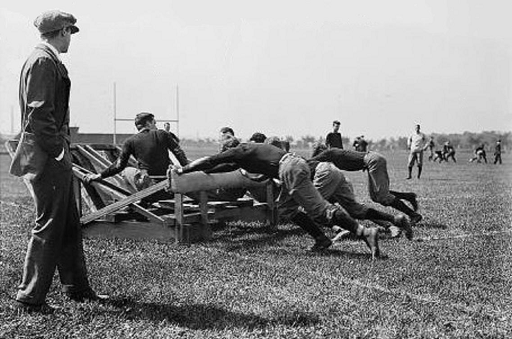
Pictured above
is Harvard coach Percy Haughton directing his charges in
training. Despite a tie with Yale in their finale, 8-0-1 Harvard would have run away with #1 in a 1910 AP poll. I covered Harvard
in my 1910 national
championship article, along with all of these teams: 9-0 Pittsburgh, 7-0 Illinois, 8-0-1 Vanderbilt, 6-0 Colorado, 7-0 Colorado College, and 6-0 Washington.
Harvard #1.
Pennsylvania, Michigan, and Minnesota
9-1-1
Pennsylvania was upset 8-5 in their opener by Ursinus (6-1, #14), and
they tied Michigan at home late in the season. They won 20-0 at Brown
(7-2-1, #5), 10-0 over Penn State (5-2-1), 18-0 over Lafayette (7-2,
#13), and 12-6 over Cornell (5-2-1, #26-39). Michigan had a very
strange season, as their 6 games went like this:
tie, win, tie, win, tie, win. So they finished 3-0-3, which is
equivalent to 4-1-1. In addition to Penn, Michigan tied Case (6-1-1,
#26-39) in their opener and Ohio State (6-1-3, #26-39) in game 3, both
very ugly for a highly-rated team, needless to say. But all 3 of
Michigan's wins were pretty good: 6-2 over Michigan State (6-1, #17), 11-0 at Syracuse (5-4-1), and most importantly, 6-0 over Minnesota in their finale.
That was Minnesota's only loss, putting them at 6-1 and probably costing them a national championship (which they earned the next season,
in my opinion). Minnesota's wins were all shutouts, and no one aside
from Michigan got within 17 points of them. But Michigan was easily the
best team they played this year, as Minnesota's top wins came over
Nebraska (7-1, #19) and South Dakota (6-2, #26-39).
Penn #2, Michigan #3, and Minnesota #4.
Brown, Navy, Army, and
Yale
7-2-1 Brown took
their losses to #1 Harvard and #2 Penn, and they were tied by Colgate
(4-2-1, #25). They only had one win of note, but it was a big one, 21-0
at Yale (6-2-2, #8). They had one weak performance other than the tie,
a 5-0 win over Rhode Island (5-1-1, unrated), but on the other hand,
those were the only points Rhode Island gave up this season.
8-0-1
Navy had a terrific straight record, obviously, but their schedule was
quite lacking and their performances rather unimpressive. Like Brown,
they took an upset tie, but Navy's came to a very poor Rutgers team
that went 3-2-3, tying Franklin & Marshall and Haverford, and
losing to NYU and Washington (Maryland). Navy only played one top 25
caliber team all year, winning 3-0 over archrival Army (6-2, #7) in
their finale. That game was played in Philadelphia, but Navy played all
the rest of their games at home. They posted close wins over 2 unrated
opponents. But on the plus side, Navy shut out every opponent this year.
In addition to Navy, 6-2 Army lost to #1 Harvard. Like Brown and Navy, Army had only one win of note, 9-3 over Yale.
As noted, 6-2-2 Yale took their losses to Brown (#5) and Army (#7). They tied 8-0-1
Vanderbilt (covered next), and in their finale they tied #1 Harvard for
their biggest "win" of the year. Yale's actual wins included 12-6 over
Syracuse (5-4-1), 19-0 over Colgate (4-2-1, #25), and the week prior to
their big tie with Harvard, they won 5-3 at 7-1 Princeton (covered
next).
Brown #5, Navy #6, Army #7, and Yale #8.
Brown
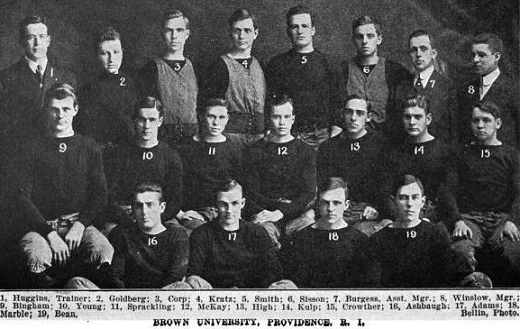
Brown's
coach was Hall of Famer Edward Robinson, a Brown grad that went
140-82-12 there over 3 stints between 1898 and 1925. Throw in a few
years at Nebraska and Maine, and he was 157-88-13 overall. This was
Brown's 2nd strongest team ever, and Robinson also coached their best,
the 1916 team that had the MNC in the bag until they were shocked by
Colgate in their finale.
If there had been a Heisman Trophy in
1910, Brown quarterback Earl Sprackling would have won it, based almost
entirely on his superhuman effort in Brown's monumental 21-0 victory
over Yale this season. In that game, he kicked 3 field goals, hit 5 of
6 passes for 180 yards and a touchdown, rushed for 36 yards, returned
punts for 150 yards, and returned kicks for 90, so he was responsible
for a total of 456 yards. And this was Brown's first-ever win over Yale
in 18 meetings. Sprackling was a consensus All American this year and
next, and he is in the Hall of Fame.
Lost in his shadow was halfback James McKay, team captain and a nonconsensus All American.
Vanderbilt, Princeton, Illinois, and Pittsburgh
8-0-1 Vanderbilt
may not have been rated higher than 7-1 Princeton in a 1910 AP poll,
but given that they tied #8 Yale, while Princeton lost to Yale,
obviously Vanderbilt ought to
be rated higher. Vanderbilt's wins all came by more than a touchdown,
and their victims included 7-1 Mississippi (#26-39), 8-2 Sewanee
(#26-39), and 5-3 Georgia Tech.
7-1 Princeton, as noted, lost a close home game to #8 Yale in their
finale. They shut out every other opponent they played, the best being
7-2 Lafayette (#13) and 5-2 Dartmouth (#15). They posted one close win
over an unrated team.
7-0 Illinois was not yet as respected as they would be just a few years
later, so there's no way they would have been rated higher than the very esteemed
Princeton. And their results didn't merit being rated higher than
Princeton anyway. Their best win was 3-0 at Indiana (6-1, #21), and
they also won 3-0 over Syracuse in their finale, and though Syracuse
was just 5-4-1 and not a top 40 team, this intersectional win
nevertheless did attract attention. Illinois also won 3-0 over 2-5
Chicago at home, a poor performance. But on the plus side, in what
appears to have been a theme in 1910, Illinois shut out every opponent.
9-0 Pittsburgh also shut out every opponent, and they won every
game by more than a touchdown, so their performance was perfect. Their
schedule, however, was practically worthless. Their best opponents were
6-1-1 Georgetown and 5-2-1 Penn State, neither of whom was top 40 caliber this
year. Penn State tied 0-4-2 Villanova at home, and Georgetown tied
North Carolina State, who tied Villanova. Most of Pitt's opponents were
minor teams, and Pitt itself was considered a "mid-major" type team at
this time (at best). Illinois, on the other hand, was solidly a major
team.
Vanderbilt #9, Princeton #10, Illinois #11, and Pittsburgh #12.
Lafayette, Ursinus, and Dartmouth
7-2 Lafayette
took their losses 18-0 at #2 Penn and 3-0 to #10 Princeton. They shut
out every other opponent, including a 10-0 win over Ursinus. They
posted one close win over an unrated opponent, which is the only
rationalization for rating Pitt higher.
6-1 Ursinus isn't a name we're used to seeing in the top 25,
probably because this is the school's only top 25 season in its
history. The loss, as noted, came to Lafayette, but Ursinus pulled off
one of the biggest wins of the season when they edged #2 Penn 8-5 in
their opener. That was their only win of note, and they posted one
close win over an unrated opponent. It should also be pointed out that
Penn used their opener against Ursinus to see which of their reserves
could prove most useful down the road, and only 2 of the players who
saw action for Penn in that game went on to become starters this season.
5-2 Dartmouth may have been rated higher than this, maybe as high
as #11, behind Princeton. The problem is, they accomplished very little
this season. Their losses came 18-0 at #1 Harvard and 6-0 to #10
Princeton at home. And that--losing to Princeton by 6--is their best
accomplishment of this season. Their 5 wins came over worthless minor
teams (Mass, Vermont, Williams, Colby, and Amherst), and one of those
games was close. No way Dartmouth belongs ahead of Ursinus, even if it was mostly Penn's backups that Ursinus beat.
Lafayette #13, Ursinus #14, and Dartmouth #15.
Ursinus
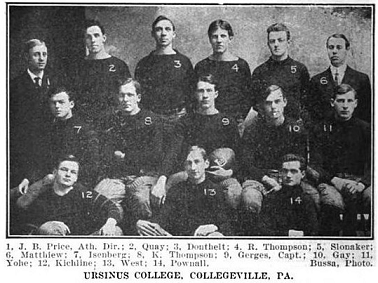
The
head coach at Ursinus was John "Whitey" Price (upper left in picture
above), who went 6-1-1 in 1909 and 6-1 this season, then crashed and
burned over his next 3 seasons, ending up 27-21-2 at Ursinus 1908-1913.
He recovered with a pair of good seasons at Trinity (Connecticut)
1914-1915, going 4-2-1 and 5-0-2, and for his career he was a pretty
decent 65-37-13 at 4 minor schools.
Washington, Michigan State, Colorado, and Nebraska
Token team time,
and we've reached the point in the top 25 where it's mostly just
guesswork as far as estimating where a 1910 AP poll would have rated
these teams. My first guess is 6-0 Washington, champion of the
Northwest and unbeaten for the 3rd straight season. How good the
Northwest was compared to the rest of the country, we'll never know.
Next
we'll go with 6-1 Michigan State, who was considered a mid-major type
team at this time (at best). They lost by only 3 points at #3 Michigan,
their best result of the season. But they also won 17-0 over 4-1-1
Notre Dame and 3-2 at 6-1-2 Marquette, and both those teams were #26-39.
Then
we've got 6-0 Colorado, co-champion of the Rocky Mountain region. They
won every game by more than a touchdown, but their schedule was very
weak.
And then we'll bring in 7-1 Nebraska, champion of the
Missouri Valley. They took their loss 27-0 at #3 Minnesota. They won
12-9 over 6-2 South Dakota (#26-39), 27-0 over 4-3-1 Denver, and 6-0 at
6-1-1 Kansas. They also posted a weak 6-0 win over a minor team, Doane.
Washington #16, Michigan State #17, Colorado #18, and Nebraska #19.
Colorado College, Indiana, and Centre
7-0 Colorado
College was our other co-champion of the Rocky Mountain region. They
posted a close 21-17 win at 4-2 Utah, whom Colorado beat 11-0, and they
posted an even closer 6-5 win at 4-3-1 Denver, whom Nebraska beat 27-0, and
on that slim evidence, we'll place Colorado College behind Colorado
and Nebraska. Colorado College did bring home a big intersectional win,
though, 15-8 over 10-1 Kansas State (#23), who won 5-0 at 7-1 Arkansas,
who won 5-0 over 8-1 Texas A&M. A pretty nice victory chain there.
6-1
Indiana took their loss to #11 Illinois by just 3 points, a great effort, but there
isn't much more to say on their behalf. Indiana beat 3 minor teams,
then 3 major teams that went 2-5, 1-5, and 1-2-2. And one of those
games was close.
9-0 Centre was the equivalent of a
lower-division school, but they beat some majors, the best being 7-2 Kentucky
and 8-2 Sewanee (yes, Sewanee was a major at this time). Sewanee was
#26-39. Centre also beat 6-3 Cincinnati, Tennessee, and Tulane.
Colorado College #20, Indiana #21, and Centre #22.
Indiana
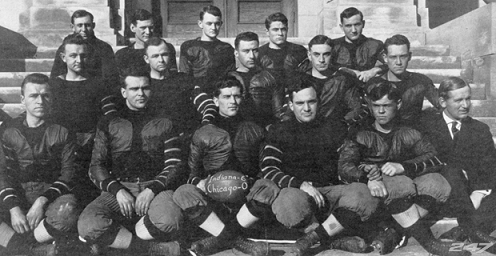
While Indiana struggled to get by 2-5 Chicago by the unimpressive
score of 6-0, that win was huge for Indiana, because it was the first
time
they ever beat Stagg's "monsters of the midway." They had never even
come within a touchdown of
Chicago before. Also, while Indiana's Big 10 opponents were weak this
year, going 3-1 in league play was unprecedented for them. Indiana had been
5-25-2 in league play before this season, and they had never won more
than one league game in a season.
The head coach was James Sheldon (lower right in picture above), who had played at Chicago for Amos Alonzo Stagg.
He went 35-26-3 at Indiana 1905-1913, making him one of the few
football coaches to manage a winning record there. But most of those
wins came over minor schools, and in Sheldon's other 8 years at Indiana
aside from this one, he only won 1 game in league play. Total.
Three players on this team were all-conference, and 4 made Outing
magazine's list of the best players in the nation. Halfback Thomas Gill
was on the Outing list, and he scored the touchdown that beat Chicago
6-0.
Kansas State, Trinity (Connecticut), and Colgate
Last
slots. First up here is 10-1 Kansas State. They took their loss at
Colorado College, and as previously noted, they won 5-0 at 7-1 Arkansas
(#26-39), who beat 8-1 Texas A&M. KSU posted a weak 6-2 win at
minor team Creighton. 8 of KSU's 11 opponents were minor teams.
7-1
Trinity (Connecticut) took their loss 17-0 at #7 Army. Their one big
win was 23-0 at 4-2-1 Colgate. Otherwise, they were a minor team that
played minor teams, and they had a couple of very weak performances in
close wins at 4-4-1 Wesleyan and at 2-4-1 NYU. This is the only top 25
caliber team Trinity ever fielded, though they were very close in 1911.
In
addition to Trinity, Colgate lost 19-0 to #8 Yale. Their one big
accomplishment was a scoreless tie at #5 Brown. That stands out as an
anomaly, since both of Colgate's losses were ugly, and they only won
6-5 at Rochester, but still, that tie was much more than the other
candidates for this slot accomplished -- without also taking an upset loss or
tie to a lower-ranked team.
Kansas State #23, Trinity (Connecticut) #24, and Colgate #25.
Kansas State
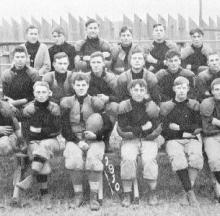
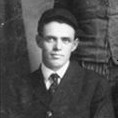 Kansas
State's coach was Mike Ahearn (pictured at left), who had gone 7-2 in
1909, then wanted to retire from coaching, but his players begged him
to come back for one more year. He did, and the result was this 10-1
season. He went 39-12 at KSU 1905-1910, giving him the highest winning
percentage of any football coach in KSU history. Ahearn was later KSU's
athletic director, 1920-1947, and he is the namesake of Ahearn Field
House there.
Kansas
State's coach was Mike Ahearn (pictured at left), who had gone 7-2 in
1909, then wanted to retire from coaching, but his players begged him
to come back for one more year. He did, and the result was this 10-1
season. He went 39-12 at KSU 1905-1910, giving him the highest winning
percentage of any football coach in KSU history. Ahearn was later KSU's
athletic director, 1920-1947, and he is the namesake of Ahearn Field
House there.
Kansas was off the schedule this year for the first
time since 1901 over an eligibility dispute. Kansas was in the Missouri
Valley Conference, which had strict eligibility rules. Kansas State was
not in the conference, and their eligibility rules were quite lax (they
allowed up to 6 years eligibility). Kansas would no longer play KSU
under those circumstances. KSU relented on the issue after this
season, instituting stricter eligibility guidelines, so that the
rivalry game could resume the next season. The series has been unbroken
since then.
Team captain and halfback George Croyle rushed for
2196 yards in his career, and the other back, Harvey Roots, scored 19
touchdowns this season.
Trinity (Connecticut)
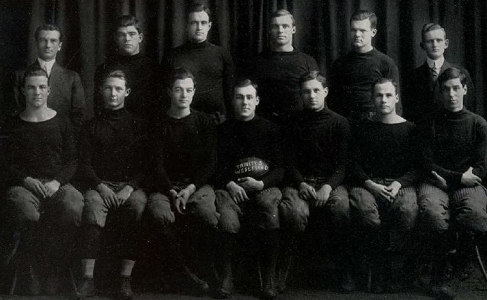
Trinity-Connecticut
was coached by Ursinus grad Raymond Gettell (upper left in team
picture). He went 34-10-6 here 1908-1913, then 17-10 at Amherst
1917-1920. He spent the rest of his career as a well-known political
science professor and speaker. He ran a creative, experimental,
wide-open offense at Trinity.
The star player was team captain
and halfback Earl Ramsdell (holding the ball in team picture). He was
an end 1907-1908, and caught most of his career 112 receptions in those
years. Ramsdell still holds the school record for touchdowns in a game
at 6, and for his career he scored 30 touchdowns.
Others
Receiving Votes
Here
are the teams closest to making this top 25. 5-0 Arizona and 5-0 Howard were too far removed from big time
football to consider.
Case 6-1-1
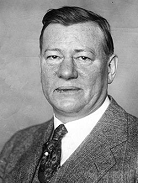 What a terrific
season it was for the Ohio Athletic Conference! Akin to today's MAC,
this conference usually did little more than supply cupcakes for the
bigger schools to pad their win-loss records, but this year the OAC
pulled off 3 big upset ties, Oberlin tying 5-2-1 Cornell, and both Case
and Ohio State tying #3 Michigan. Prior to this season, Oberlin had
been 0-8 against Cornell, Case had been 0-13 against Michigan, and Ohio
State had been 0-10-1 against Michigan.
What a terrific
season it was for the Ohio Athletic Conference! Akin to today's MAC,
this conference usually did little more than supply cupcakes for the
bigger schools to pad their win-loss records, but this year the OAC
pulled off 3 big upset ties, Oberlin tying 5-2-1 Cornell, and both Case
and Ohio State tying #3 Michigan. Prior to this season, Oberlin had
been 0-8 against Cornell, Case had been 0-13 against Michigan, and Ohio
State had been 0-10-1 against Michigan.
6-1-1 Case, short for
Case Institute of Technology, would eventually merge with fellow
Cleveland school Western Reserve in 1967 to form Case Western Reserve.
Case only once fielded a top 25 caliber team, in 1903, but this season
they were close. Their loss came 6-0 to Oberlin (covered next), which
gave Oberlin the OAC title. Case maintained after the game that on the
winning touchdown, the runner had clearly gone out of bounds, and so
they stopped pursuing him. The referee, however, did not rule him out
of bounds. Case's big "win" was their tie, of course, the 3-3
effort at #3 Michigan. Otherwise, their best wins came 14-10 over Ohio
State (covered below) and 3-0 over 6-4 Western Reserve.
The tie
with Michigan does not get Case into the top 25 because #25 Colgate
tied #5 Brown, but took no losses or ties to unranked teams, whereas
Case lost to unranked Oberlin. And Colgate almost certainly would have
been ranked higher in a 1910 AP poll anyway.
Case's head coach was
Wisconsin grad Joe Fogg (pictured), who went 25-8-4 here 1907-1910. Years later he
founded the Cleveland Touchdown Club, which still gives an annual award
in his name to the best college player in the Midwest. Case's star and
captain was halfback Robert Twitchell, who was all-Ohio in 1909 and
1910.
Oberlin 5-1-2
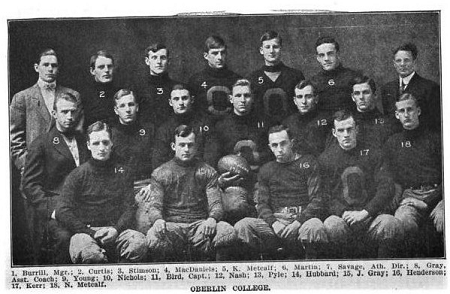
5-1-2 Oberlin
took their loss 3-0 at home to 7-2 Akron, who was rather poor despite
their nice-looking straight record. Akron lost to the only other good
teams they played, 6-4 Western Reserve (not close to being ranked) and
4-1-1 Notre Dame (who trounced them 51-0). Oberlin's ties came to 5-2-1
Cornell (covered below), whom they had been 0-8 against, usually by big
scores, and to Ohio State (covered next). Oberlin's big win came 6-0 at
Case, giving Oberlin the OAC title. But that's only because Akron was
not in the OAC (despite playing what looked like an OAC schedule), so
Oberlin's loss to them didn't count in the OAC standings. Oberlin's
other win of note was an 8-6 victory over 6-4 Western Reserve.
In
national rankings, such as this one, Oberlin's loss to Akron, combined
with their tie to Ohio State, leaves them logically belonging ranked
behind Case despite the head-to-head result. I'm thinking both should be ranked about #30-35.
Pretty good for Oberlin, but this isn't actually the school's best
season -- they'll be ranked #25 for 1921. And Oberlin's coach in 1921
was a player on this 1910 team.
That would be tackle/end T.
Nelson Metcalf (#18 in team picture, lower right). He went 6-1-1 as coach at Oberlin in 1913, then 19-3-1
here 1919-1921, which is obviously very impressive, but most of his
career would be spent as an athletic director, first at Iowa State
1924-1933, then replacing Amos Alonzo Stagg at Chicago 1933-1956. He
oversaw the ending of Chicago's football program and their consequent exit from the Big 10. And there was another
future athletic director on this team. Quarterback J. Herbert Nichols (#10 in team picture)
was all-Ohio, and after working as a referee for 23 years, he returned
to Oberlin and served as AD 1935-1955.
Oberlin had won the OAC
in 1909 too, but they had lost 8 of their 11 starters from that team,
so this year's repeat was a bit of a miracle on the part of head coach
Harvey Snyder. He was a Harvard grad who went 20-11-6 at Oberlin
1906-1910. Then he did less well at Western Reserve 1911-1913, going
13-11-5, before returning to Harvard to work as an assistant coach to
Percy Haughton.
Ohio State 6-1-3
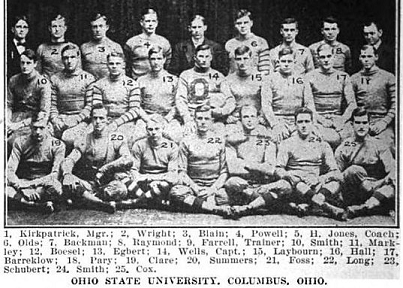
6-1-3 Ohio State was also in the OAC, competing with the likes of
Case and Oberlin, but they were just a few years away from moving up to
the big leagues by joining the Western Conference (Big 10). This year
they took their one loss to Case (covered above), and the 3 ties came
to #3 Michigan, to Oberlin (covered above), and to 3-4-2 Denison (a
very weak team). The tie with Michigan was obviously their big "win,"
but they also won 6-0 over 6-4 Western Reserve and 23-0 over 6-3
Cincinnati.
Ohio State had a big-time coach stopping in for just this one season, Hall of Famer Howard
Jones (middle of back row in team picture). A Yale grad, he had played for MNC teams in 1905, 1906, and 1907, and then he coached Yale to another MNC in 1909
just prior to coming to OSU. In the 1920s, he would win a national
championship as Iowa's coach, then a couple more as Southern Cal's
coach.
The key player this year was halfback Leslie Wells, who was team captain and all-Ohio.
Cornell 5-2-1
5-2-1 Cornell
took their losses to #1 Harvard and #2 Penn, and they were tied by
Oberlin (covered above). The Penn game was close, 12-6, and that is
Cornell's best accomplishment of the season, as they didn't beat anyone
of any value.
Mississippi 7-1
7-1 Mississippi
took their loss at #9 Vanderbilt. Most of their wins were dominating,
including an impressive 30-0 rout of 7-2 Mississippi State, but they
mysteriously struggled to win just 2-0 over Tennessee Medical College,
a team they played again later in the season and properly smashed 44-0.
Ole Miss shut out every opponent but Vanderbilt.
The coach this
year was Dr. Nathan Stauffer, who went 17-7-2 here 1909-1911. The star
player was all-Southern tackle Earl Kinnebrew.
Sewanee 8-2
8-2 Sewanee, aka
University of the South, took their losses to #9 Vanderbilt and #22
Centre. Like Ole Miss, they struggled in a game against Tennessee
Medical, winning 6-0. Their best win was 15-12 over 6-2-1 Georgia, not
nearly as impressive as Mississippi's best win. And since Ole Miss did
better against Vanderbilt than Sewanee did, even if Sewanee was ranked
in the top 25, it would have to be behind Ole Miss.
Arkansas 7-1
7-1 Arkansas
lost 5-0 at home to #23 Kansas State. Their one big win came 5-0 at
home over 8-1 Texas A&M (covered next). They posted a couple of
weak performances, 13-12 over Southwestern (Texas) and 6-2 over
Missouri-Rolla, both losing teams.
Texas A&M 8-1
8-1
Texas A&M, as noted above, took their loss 5-0 at 7-1 Arkansas.
Their best win was 14-8 over 5-2-1 Texas. Like Arkansas, A&M
struggled to get by 2-3-1 Southwestern (Texas).
South Dakota 6-2
6-2
South Dakota took their losses 17-0 at #4 Minnesota and 12-9 at #19
Nebraska. The close Nebraska loss was their best accomplishment, as
they did not beat anyone of any value this season. But their wins all
came by more than a touchdown, so their performance was strong.
Oregon 4-1
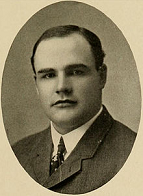
4-1
Oregon took their loss to the Multnomah Athletic Club, a team made up
of former college players, mostly from the Northwest, but also from
Wisconsin, Notre Dame, and Eastern schools. Otherwise, Oregon performed
about as well as #16 Washington, so the reality is, if Washington was
one of the 25 best teams of 1910, Oregon likely was as well. Oregon
rolled up 114 points on one patsy, and they won 29-0 over 4-2 Idaho and
12-0 at 3-2-1 Oregon State.
Oregon's head coach was Bill Warner (pictured),
a Hall of Fame player at Cornell 1899-1902, and mostly famous for being
Pop Warner's brother (and frankly, that is what got him into the Hall
of Fame). His coaching career was much, much shorter than his brother's
was, and he was just here at Oregon 2 seasons, going 4-1 this year and
3-2 the next.
The star player was quarterback Earl Latourette, a
2-time all-Northwest player who later became chief justice of the
Oregon Supreme Court. His brother was the quarterback for the Multnomah
Athletic Club, the team that beat Oregon. Halfback C. M. Taylor was selected by Walter Camp as a
3rd team All American.
Wabash 4-0
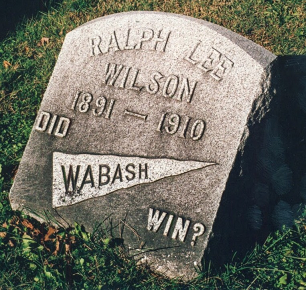
4-0
Wabash probably doesn't belong here, as they barely won 3-0 at 1-5
Purdue, their only game against a major opponent, but they were
unbeaten and untied, and they did shut out every opponent in their
short season. They also had a Hall of Fame coach in Jesse Harper, soon
to make a name for himself at Notre Dame.
Wabash suffered a
tragedy in their 4th game at St. Louis, when halfback Ralph Wilson took
a blow to the head, and died the next day. The team voted to end the
season at that point, which is why Wabash only played 4 games. Wilson
had been knocked unconscious on the field, but regained consciousness
briefly back at the hotel, and he asked, "Did Wabash win?" These were
allegedly his final words, and they have become something of a hallowed
bit of lore at Wabash ever since. They are still printed on a sign in
the Wabash locker room, as well as on Wilson's grave.
Notre Dame 4-1-1
4-1-1
Notre Dame took their loss 17-0 at #17 Michigan State, and they tied at
6-1-2 Marquette (covered below). Their big win came by the eye-opening
score of 51-0 over 7-2 Akron, which matters mostly because Akron upset
Oberlin (covered above), and since Oberlin beat Case and tied Cornell
and Ohio State, you could therefore rank Notre Dame and Marquette ahead
of all those teams. Of course, that would still leave Notre Dame and
Marquette outside the top 25.
Marquette 6-1-2
6-1-2
Marquette took their loss by just 3-2 to #17 Michigan State. Their ties
came to 4-1-1 Notre Dame (covered above) and to 4-3-1 Denver. Since
Utah (covered next) routed Denver 20-0, you could rank Utah ahead of
both Marquette and Notre Dame. Marquette's wins all came by more than a
touchdown, but those opponents were all minor teams of no importance.
Utah 4-2
4-2
Utah makes a 3rd Rocky Mountain conference team getting mention here.
The other 2, Colorado and Colorado College, are both in the top 25, and
they're the teams that dealt Utah their losses. The Colorado College
game was close, 21-17. Utah defeated 4-3-1 Denver 20-0, which is what
gets Utah on this list, because Denver tied 6-1-2 Marquette (covered
above), who tied 4-1-1 Notre Dame (also covered above). Utah also gave
5-2 Utah State both of their losses, as they opened and closed the
season against them. Utah had 3 all-conference players, one of whom,
fullback Henry Richardson, scored a late touchdown and kicked the
extra point to beat Colorado Mines 6-0.
1910
Top 25
1) Harvard 8-0-1
2) Pennsylvania 9-1-1
3) Michigan 3-0-3
4) Minnesota 6-1
5) Brown 7-2-1
6) Navy 8-0-1
7) Army 6-2
8) Yale 6-2-2
9) Vanderbilt 8-0-1
10) Princeton 7-1
11) Illinois 7-0
12) Pittsburgh 9-0
13) Lafayette 7-2
14) Ursinus 6-1
15) Dartmouth 5-2
16) Washington 6-0
17) Michigan State 6-1
18) Colorado 6-0
19) Nebraska 7-1
20) Colorado College 7-0
21) Indiana 6-1
22) Centre 9-0
23) Kansas State 10-1
24) Trinity (Connecticut) 7-1
25) Colgate 4-2-1
Others
Receiving Votes:
Case 6-1-1
Oberlin 5-1-2
Ohio State 6-1-3
Cornell 5-2-1
Mississippi 7-1
Sewanee 8-2
Arkansas 7-1
Texas A&M 8-1
South Dakota 6-2
Oregon 4-1
Wabash 4-0
Notre Dame 4-1-1
Marquette 6-1-2
Utah 4-2






 Kansas
State's coach was Mike Ahearn (pictured at left), who had gone 7-2 in
1909, then wanted to retire from coaching, but his players begged him
to come back for one more year. He did, and the result was this 10-1
season. He went 39-12 at KSU 1905-1910, giving him the highest winning
percentage of any football coach in KSU history. Ahearn was later KSU's
athletic director, 1920-1947, and he is the namesake of Ahearn Field
House there.
Kansas
State's coach was Mike Ahearn (pictured at left), who had gone 7-2 in
1909, then wanted to retire from coaching, but his players begged him
to come back for one more year. He did, and the result was this 10-1
season. He went 39-12 at KSU 1905-1910, giving him the highest winning
percentage of any football coach in KSU history. Ahearn was later KSU's
athletic director, 1920-1947, and he is the namesake of Ahearn Field
House there.
 What a terrific
season it was for the Ohio Athletic Conference! Akin to today's MAC,
this conference usually did little more than supply cupcakes for the
bigger schools to pad their win-loss records, but this year the OAC
pulled off 3 big upset ties, Oberlin tying 5-2-1 Cornell, and both Case
and Ohio State tying #3 Michigan. Prior to this season, Oberlin had
been 0-8 against Cornell, Case had been 0-13 against Michigan, and Ohio
State had been 0-10-1 against Michigan.
What a terrific
season it was for the Ohio Athletic Conference! Akin to today's MAC,
this conference usually did little more than supply cupcakes for the
bigger schools to pad their win-loss records, but this year the OAC
pulled off 3 big upset ties, Oberlin tying 5-2-1 Cornell, and both Case
and Ohio State tying #3 Michigan. Prior to this season, Oberlin had
been 0-8 against Cornell, Case had been 0-13 against Michigan, and Ohio
State had been 0-10-1 against Michigan.


